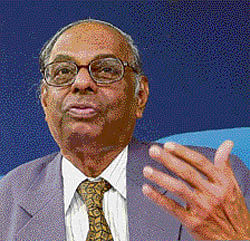Rising prices pose challenge, says PM panel

Admitting that inflation triggered by foodgrain price rise did not moderate as expected by the government, C Rangarajan, Chairman, Economic Advisory Council to Prime Minister, said managing inflationary risk was the biggest challenge in the short run.
Inflation was triggered by the increase in foodgrain prices and the government expected that it would moderate in 2011 but this did not happen, he said here.
However, he said the 8.43 per cent year-on-year inflation, as measured by Wholesale Price Index as of December, 2010, was expected to come down to around seven per cent by March 2011.
Delivering the G K Sundaram Endowment Lecture organised by South India Cotton Association, he said managing inflationary risk, particularly foodgrain price inflation, was the biggest challenge in the short run as “we had two years of high inflation.”
The food price inflation last year was triggered by rise in prices of vegetables, fruits and eggs, meat and fish, he said, adding the primary answer for food price inflation lay in improved agricultural production and increasing emphasis on the production of vegetables and fruits as well as eggs and milk became necessary.
On the growth of economy, he said it would clock nine per cent in 2011-12. While agricultural growth rate may moderate, the industry and service sectors would grow faster. India’s savings rate had touched 34 per cent of GDP and the investment rate exceeded 36 per cent of GDP, which should facilitate nine per cent growth in a sustained way, he said.
“However, we also needed to remove the constraints that may come in the way, for this to happen,” he said.
Rangarajan said the economy would grow by 8.5 per cent in the current year as there will be a substantial jump in agricultural production. “The monsoon has been good and, therefore, the agriculture GDP may grow by 4.5 per cent during the year,” he said.
Stating that industrial production had also been stronger even though it started slowing down in the last few months, Rangarajan said from April to November in the current fiscal the manufacturing sector grew by 9.5 per cent.
“With the jump in agricultural production and with industrial and service sectors growing more or less at the same rate as last year, we should be able to get a growth rate of 8.5 per cent,” Rangarajan said.
However, he said some important challenges should be addressed to sustain the high rate of growth achieved in recent years. The first challenge was to step up the growth rate of agriculture sector, critical for expanding employment, generating broadbased growth and sustained poverty reduction.
The second critical constraint was the infrastructure deficit more particularly, in power and the third one on the way forward was fiscal consolidation which was necessarily a pre-requisite for sustained growth, he said.
The fourth important challenge was investment in social infrastructure, particularly in the twin merit good of primary education and basic health, he said adding “we need to spend more on education and health.”
The fifth and final challenge was the issue of governance, which was at the very heart of “economic growth and poverty reduction and even political legitimacy, was now now part of conventional wisdom.”